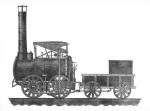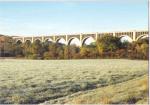![header=[Marker Text] body=[Terminus of the waterway uniting the Hudson and Delaware rivers. Built in 1825-28. A gravity railroad feeder reached to Carbondale. For seventy years the anthracite trade outlet for the region.] sign](http://explorepahistory.com/kora/files/1/10/1-A-1C7-139-ExplorePAHistory-a0b2h6-a_450.gif)
Mouse over for marker text
Name:
Delaware and Hudson Canal
Region:
Poconos / Endless Mountains
County:
Wayne
Marker Location:
US 6 and PA 191 (Main St.) at historical society, Honesdale
Dedication Date:
May 28, 1947
Behind the Marker
In the early 1800s, railroads were the hottest investment in the nation. For decades, they fueled great waves of speculative investment that alternately fueled and collapsed the growth of the American economy. Giant enterprises that required enormous sums of money to construct, most railroads were funded by stock offerings to investors. Chartered on April 23, 1823, the Delaware and Hudson Canal Company (D&H) had one of the great initial public offerings (IPOs) of the early nineteenth century.
The D&H was the brainchild of brothers Maurice and William Wurts (sometimes spelled "Wurtz"), Philadelphia merchants who owned coal lands and navigation rights in a prime anthracite region in northeastern Pennsylvania. They were granted charters by both New York State and the General Assembly of Pennsylvania, the latter of which empowered the brothers "to improve the navigation of the Lackawaxen River" for thirty years. Because the Philadelphia market was already saturated with anthracite from the coalfields above Reading, they focused on New York.
To build a canal that carried their coal to New York City, the brothers needed to raise capital. They decided to sell stock in the company to investors at the Tontine Coffee House on Wall Street, a forerunner of the New York Stock Exchange. On January 7, 1825, the Delaware and Hudson Canal Company offered $1.5 million worth of stock to public investors. By early afternoon, the entire issue had been sold.
With funding in hand, the Wurts built a canal that was reported by some observers at the time to be the most expensive privately-funded venture in American history. At one point, the company employed more than 2,500 men, at a cost of $12 to $14 per month, to build the 108-mile waterway and its 140 bridges and 108 locks. The canal's channel was twenty feet wide at its bottom, twenty-eight feet wide at the water line, and four feet deep. Engineer John Roebling, who would later build the Brooklyn Bridge, built four suspension aqueducts for the company, one of which still stands. When completed in 1828, the D&H canal extended from Honesdale, Pa., to the Delaware River on the Pennsylvania-New Jersey-New York boundaries, and included a section to Kingston on the Hudson River.
John Roebling, who would later build the Brooklyn Bridge, built four suspension aqueducts for the company, one of which still stands. When completed in 1828, the D&H canal extended from Honesdale, Pa., to the Delaware River on the Pennsylvania-New Jersey-New York boundaries, and included a section to Kingston on the Hudson River.
D&H was also a pioneer in American railroading. To carry coal from the mines down to the canal, the company bought a locomotive from England's Foster, Rastrick, and Company, which was named Lion or Stourbridge Lion. The Lion made its first test run on D&H's own railroad track near Honesdale on August 8, 1829 - the first use of a steam locomotive on an American railroad. But the Lion proved to be too heavy for the wooden track, and it was quickly sidelined for use as a stationary steam boiler.
Stourbridge Lion. The Lion made its first test run on D&H's own railroad track near Honesdale on August 8, 1829 - the first use of a steam locomotive on an American railroad. But the Lion proved to be too heavy for the wooden track, and it was quickly sidelined for use as a stationary steam boiler.
While the initial use of a steam locomotive failed, the combined technology of steam propulsion and a guided track soon revolutionized American transportation. By the mid-1940s, America echoed with the panting sounds and shrill whistles of 45,000 steam locomotives, including those of the D&H.
For seventy years, the D&H canal moved millions of tons of coal to market. When it was dissolved on April 28, 1899, the corporation simplified its name to the Delaware and Hudson Company, which operated the Delaware and Hudson Railroad Company. The railroad linked Montreal with Albany and Binghamton, New York, and Scranton and Wilkes-Barre, Pennsylvania, and the latter line passed directly beneath the massive Starrucca Viaduct. As the anthracite industry declined, D&H became less dependent on coal transportation and embraced its identity as a "bridge line" - a route that promoted the flow of "overhead" freight that did not originate or terminate on its lines, but rather went straight through on a north-south journey.
Starrucca Viaduct. As the anthracite industry declined, D&H became less dependent on coal transportation and embraced its identity as a "bridge line" - a route that promoted the flow of "overhead" freight that did not originate or terminate on its lines, but rather went straight through on a north-south journey.
In the 1960s, D&H was taken over by Dereco, a holding company of the Norfolk and Western Railway, as part of an unrealized merger proposal. It continued to operate somewhat independently and, in 1973, D&H celebrated its 150th-year anniversary as a company, dating from the 1823 charter of the canal.
In 1976, D&H expanded its reach considerably with the complete reorganization of Northeastern railroads. Following the bankruptcies in the 1970s of the sprawling Penn Central and most of the old anthracite lines (Lehigh Valley, Reading, Erie-Lackawanna, and Lehigh and Hudson River), Congress formed the U.S. Railway Association (USRA). Its job was to oversee the carving up of tracks and geography in order to form Conrail, the federally backed plan to merge, bail out, and prop up the bankrupt railroads.
Under a plan approved by Congress, USRA expanded D&H, giving the company trackage-rights access over Conrail lines to New York City via Allentown and Bethlehem; to Philadelphia via Allentown and Reading; to Buffalo via Elmira, N.Y.; and to Washington via Sunbury, Harrisburg and Baltimore. The expansion roughly doubled D&H's 900-route-mile length. D&H began running trains on these expanded routes on April 1, 1976. In 1980, it negotiated with Conrail to purchase a sixty-mile stretch of the former Lackawanna Railroad main line between Scranton and Binghamton, N.Y. With this acquisition, D&H also acquired the landmark Tunkhannock Viaduct.
Tunkhannock Viaduct.
Surrounded by Conrail lines, however, D&H floundered and was then taken over by Guilford Transportation Industries of New England, which blended D&H operations with its other lines, and in 1987 placed D&H into bankruptcy. It was then taken over by Canadian Pacific Railway (CP Rail), one of the two massive Canadian transcontinental systems. CP continues to operate freight trains through Pennsylvania - via Tunkhannock Viaduct - over the former D&H routes.
The D&H was the brainchild of brothers Maurice and William Wurts (sometimes spelled "Wurtz"), Philadelphia merchants who owned coal lands and navigation rights in a prime anthracite region in northeastern Pennsylvania. They were granted charters by both New York State and the General Assembly of Pennsylvania, the latter of which empowered the brothers "to improve the navigation of the Lackawaxen River" for thirty years. Because the Philadelphia market was already saturated with anthracite from the coalfields above Reading, they focused on New York.
To build a canal that carried their coal to New York City, the brothers needed to raise capital. They decided to sell stock in the company to investors at the Tontine Coffee House on Wall Street, a forerunner of the New York Stock Exchange. On January 7, 1825, the Delaware and Hudson Canal Company offered $1.5 million worth of stock to public investors. By early afternoon, the entire issue had been sold.
With funding in hand, the Wurts built a canal that was reported by some observers at the time to be the most expensive privately-funded venture in American history. At one point, the company employed more than 2,500 men, at a cost of $12 to $14 per month, to build the 108-mile waterway and its 140 bridges and 108 locks. The canal's channel was twenty feet wide at its bottom, twenty-eight feet wide at the water line, and four feet deep. Engineer
D&H was also a pioneer in American railroading. To carry coal from the mines down to the canal, the company bought a locomotive from England's Foster, Rastrick, and Company, which was named Lion or
While the initial use of a steam locomotive failed, the combined technology of steam propulsion and a guided track soon revolutionized American transportation. By the mid-1940s, America echoed with the panting sounds and shrill whistles of 45,000 steam locomotives, including those of the D&H.
For seventy years, the D&H canal moved millions of tons of coal to market. When it was dissolved on April 28, 1899, the corporation simplified its name to the Delaware and Hudson Company, which operated the Delaware and Hudson Railroad Company. The railroad linked Montreal with Albany and Binghamton, New York, and Scranton and Wilkes-Barre, Pennsylvania, and the latter line passed directly beneath the massive
In the 1960s, D&H was taken over by Dereco, a holding company of the Norfolk and Western Railway, as part of an unrealized merger proposal. It continued to operate somewhat independently and, in 1973, D&H celebrated its 150th-year anniversary as a company, dating from the 1823 charter of the canal.
In 1976, D&H expanded its reach considerably with the complete reorganization of Northeastern railroads. Following the bankruptcies in the 1970s of the sprawling Penn Central and most of the old anthracite lines (Lehigh Valley, Reading, Erie-Lackawanna, and Lehigh and Hudson River), Congress formed the U.S. Railway Association (USRA). Its job was to oversee the carving up of tracks and geography in order to form Conrail, the federally backed plan to merge, bail out, and prop up the bankrupt railroads.
Under a plan approved by Congress, USRA expanded D&H, giving the company trackage-rights access over Conrail lines to New York City via Allentown and Bethlehem; to Philadelphia via Allentown and Reading; to Buffalo via Elmira, N.Y.; and to Washington via Sunbury, Harrisburg and Baltimore. The expansion roughly doubled D&H's 900-route-mile length. D&H began running trains on these expanded routes on April 1, 1976. In 1980, it negotiated with Conrail to purchase a sixty-mile stretch of the former Lackawanna Railroad main line between Scranton and Binghamton, N.Y. With this acquisition, D&H also acquired the landmark
Surrounded by Conrail lines, however, D&H floundered and was then taken over by Guilford Transportation Industries of New England, which blended D&H operations with its other lines, and in 1987 placed D&H into bankruptcy. It was then taken over by Canadian Pacific Railway (CP Rail), one of the two massive Canadian transcontinental systems. CP continues to operate freight trains through Pennsylvania - via Tunkhannock Viaduct - over the former D&H routes.








